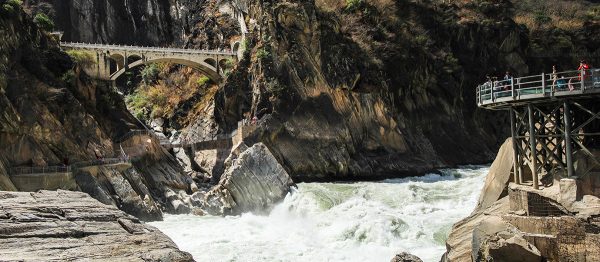
Legend has it that, long ago, a tiger was running from a hunter when he was cornered on the river banks. With the rapids thundering behind him and the gorge rising up on all sides, he had nowhere to go. Suddenly, as the hunter approached, the tiger leapt from the bank to a rock in the centre of the rushing water, and then jumped to safety on the opposite bank. Supposedly the tiger cleared 25 metres (82 ft.) in order to escape the hunter, a feat unmatched by any modern tiger, and since then it has been known as Tiger Leaping Gorge.
The gorge is made up of a canyon with the Jinsha River running through it. It can be found about 60 kilometres (37 mi) north of Lijiang City and, since the Jinsha River makes up the upper reaches of the magnificent Yangtze River, it is part of the Three Parallel Rivers Site. At its maximum depth, there is approximately 3,790 metres (12,434 ft.) from river to mountain peak, making Tiger Leaping Gorge one of the deepest river canyons in the world.
It marks the point where the river passes between the colossal Jade Dragon Snow Mountain and the Haba Snow Mountain. At its base, the gorge stretches 15 kilometres in length and is flanked on one side by a series of rapids and on the other by 2,000 metre-high cliffs. With that in mind, I’m sure we can all appreciate how terrifying it must have been to leap over!
Due to its ecological importance, the area itself is now protected. Several different ecological and climate zones meet in the region, which has resulted in an unusually large number of plant and animal species thriving here. Many rare plants and animals can be found in the gorge, making wildlife preservation of paramount importance. If only that had been the case years ago, and then perhaps it would be called Tiger Resting Gorge instead!
It is now a popular tourist location for both Chinese and foreign tourists who want to enjoy a challenging hike and admire the magnificent scenery. There are a number of hiking trails you can take, but most of them begin near the Upper Gorge in the town of Qiaotou, also known as Tiger Leaping Gorge Town, and finish in the town of Daju near the Lower Gorge. The Lower Trail is the shortest, easiest and most popular with Chinese tourists. It is made up of a road that was recently built along the south side of the river, which you can either hike or take a tour bus along. This trail offers wonderful views of the foaming waters as they rush through the gorge and will take you past the Tiger Leaping Rock, making it the ideal option if you don’t feel up to the more strenuous hikes.
The High Trail can only be hiked and provides the perfect opportunity to enjoy a little solitude, revelling in the true majesty of the gorge. Most of the trail is at an elevation of about 2,700 metres (8,800 ft.) and is mostly one kilometre above the river, meaning you can still hear the water as it thunders below you. The trail is approximately 22 kilometres (14 mi) long and features a number of micro-ecosystems, waterfalls and verdant forests along the way. Many locals from the Naxi ethnic minority live in nearby villages and use this trail daily, meaning you can connect with some of the ethnic culture whilst hiking. Be forewarned, the Naxi people are a matriarchal culture and their women are notoriously bossy, so don’t cross one or you might end up leaping across the gorge yourself!
If you fancy a real challenge, you can enhance your hiking experience by taking the optional trails to Walnut Grove and the Bamboo Forest. The High Trail descends to meet the Low Trail at Tiger Leaping Rock, which is the point along the river where the tiger supposedly leapt over.
Depending on your speed, the trail should take you between one and a half days to three days. We recommend you take a leisurely pace, as this affords the opportunity to stop and marvel at the scenery on your way. There are plenty of guesthouses and hotels littered throughout the trail that provide hikers with supplies, meals and a place to stay.
The trails are all considered impassable during the rainy season, which is from June to September. Heavy rain increases the risk of landslides and people have died there before during adverse weather conditions. We strongly recommend that you avoid visiting during this season, as it is not worth the risk. The best times to hike the gorge are October, November and May, as the weather is temperate but not too wet.
2 Replies to “Tiger Leaping Gorge”